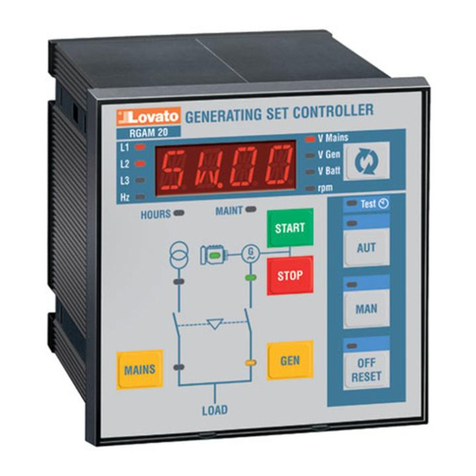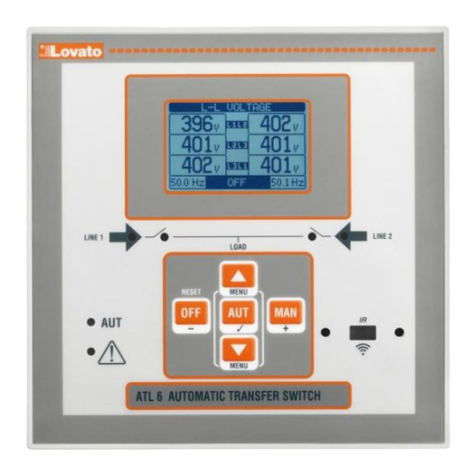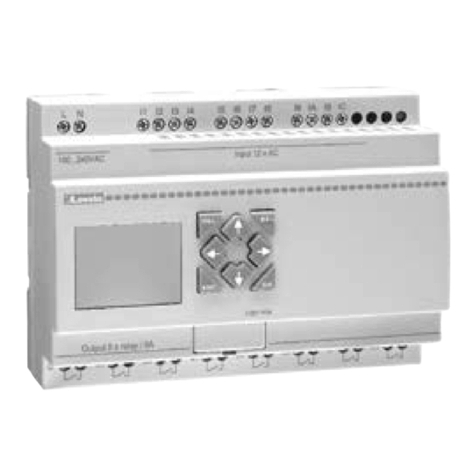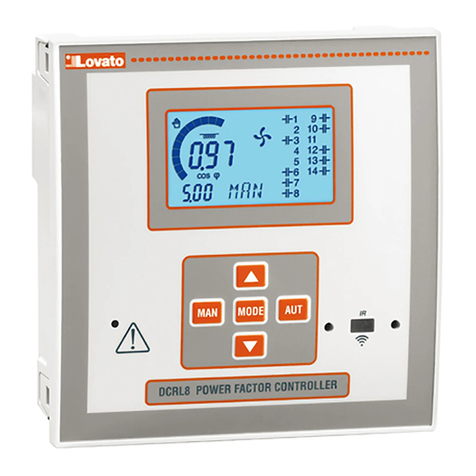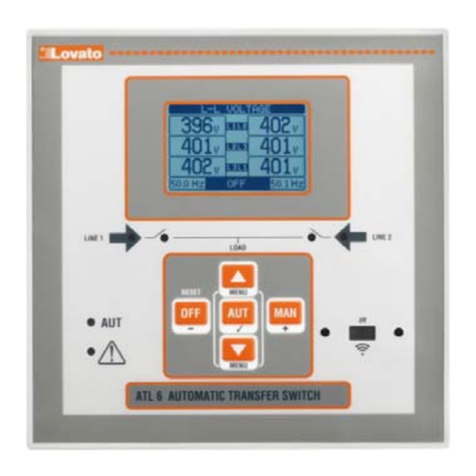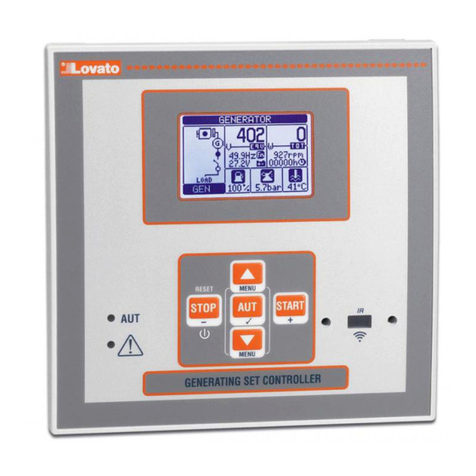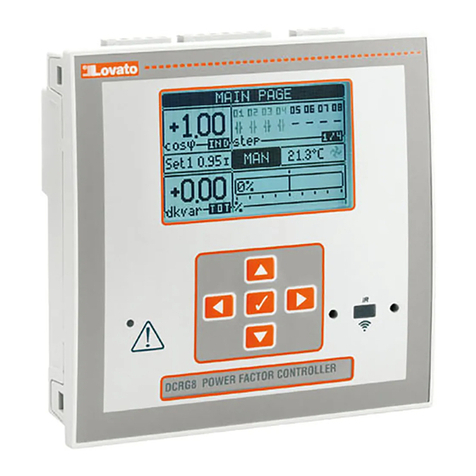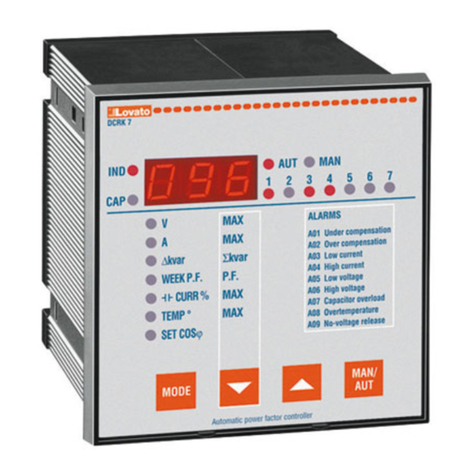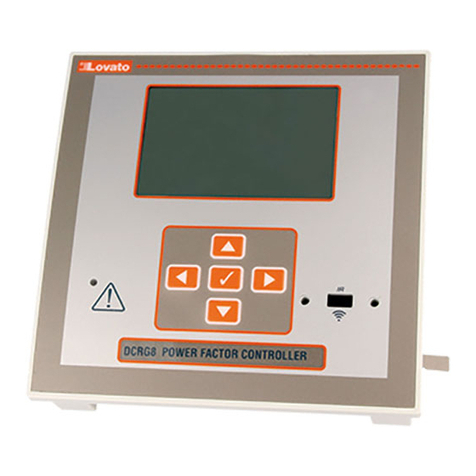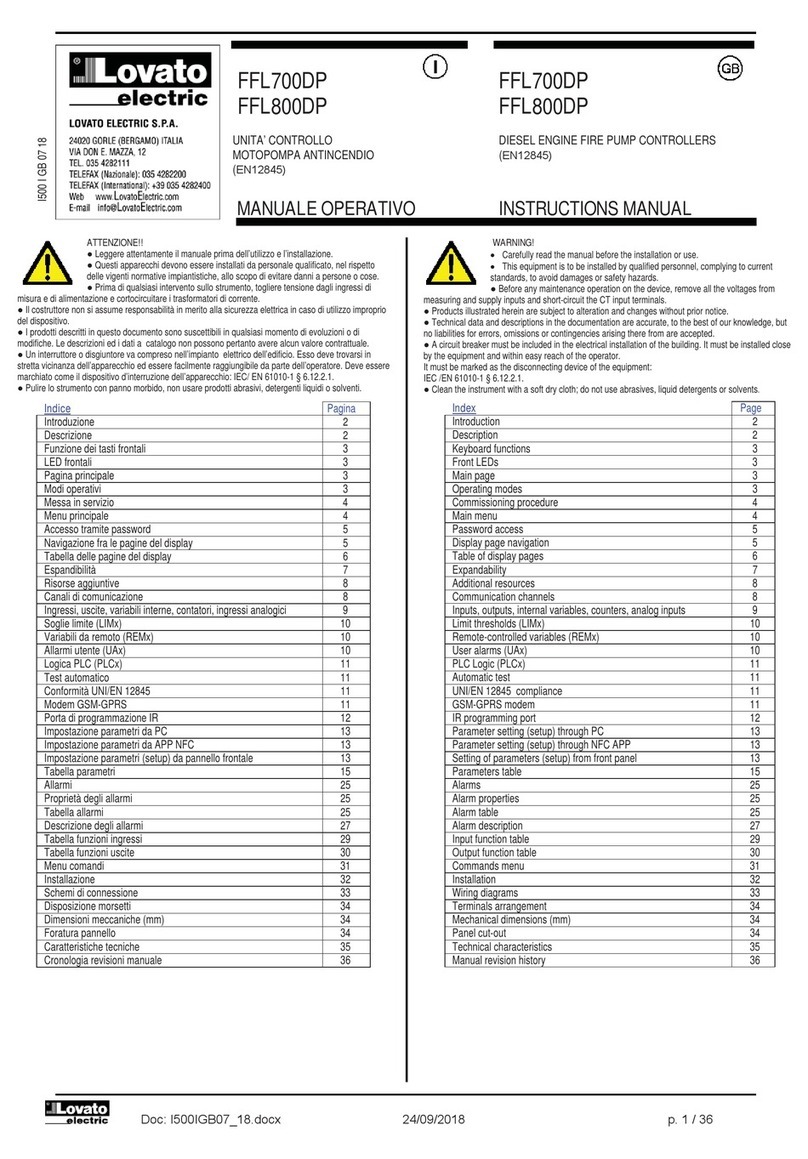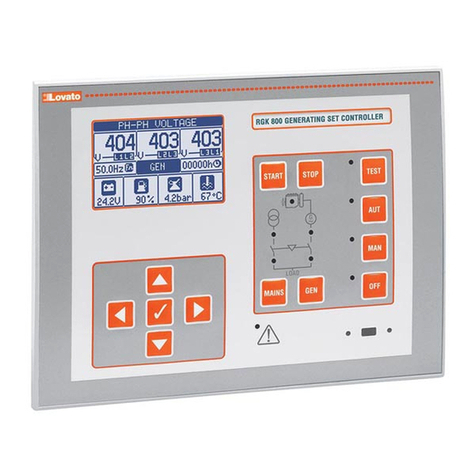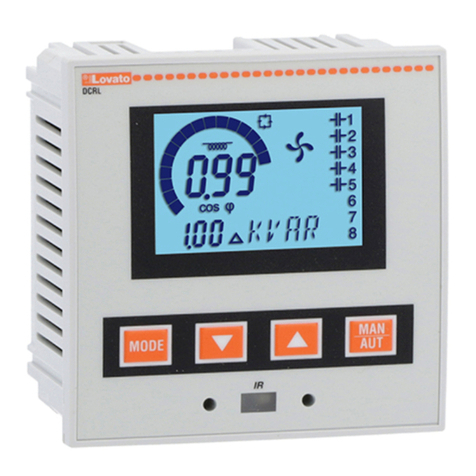
Doc: MHIT100A0309_ATL10 10/11/2009 s. 7 / 22
KONTROLA NAPIĘCIA
Wszystkie warunki które, pozwalająustalićczy źródło
zasilania jest odpowiednie czy nie, sązdefiniowane
przez użytkownika poprzez menu P1 (zakresy)
i menu P3 i P4 (limity napięcia linii 1 i linii 2).
Zakresy sytemu mogąbyćustawione przez menu P1,
włącznie z napięciem znamionowym
i częstotliwością, które będąużywane jako odnośnik
przy ustawianiu progów procentowych.
Stosunek napięcia (VT) może byćustawiony kiedy,
używane jest na wejściach jednostki napięcie niższe
niżaktualne napięcie systemu. Także w tym
przypadku, obie wizualizacje i ustawione progi
będąporównywane do wielkości odnośnych systemu.
Sterownik może byćprogramowany by pokazywać
napięcie kontrolowane na trzech fazach z lub bez
przewodu neutralnego, dwóch fazach lub jednej.
(P1.03)
W przypadku układów trójfazowych czy
dwufazowych, można wybraćczy monitorujemy
napięcie L-L czy L-N, czy teżoba (P1.04). W każdym
przypadku, napięcie znamionowe ustawione poprzez
parametr P1.01 musi byćrówne napięciu
międzyfazowemu.
Poniższa tabela przedstawia listęparametrów
kontrolowanych na każdej z linii. Kropka w tabeli OFF
oznacza, że mogąone byćwyłączone
Każda anomalia ma niezależny czas opóźnienia.
Anomalia musi trwaćdłużej niżwyznaczony czas
do unieważnienia sygnału obecności napięcia.
Kiedy wszystkie parametry linii sąw wymienionych
limitach, musi upłynąć czas opóźnienia by linia mogła
byćużyta. Czas trwania tego opóźnienia jest
wyrażony w dwóch niezależnych parametrach, jeden
zdefiniowany czas opóźnienia kiedy alternatywna
linia jest dostępna, i drugi, normalnie krótszy, kiedy
alternatywna linia jest nie dostępna.
Wszystkie typy kontroli, oprócz minimalnego
napięcia, mogąbyćwyłączone niezależnie poprzez
ustawienie odpowiedniego parametru na OFF.
Limity minimalnego i maksymalnego napięcia
sąwyspecyfikowane poprzez ustawienie dwóch
progów dla każdego, jeden definiujący punkt poza
którym napięcie nie jest akceptowalne (np. P3.01,
spadek) i drugi, bliższy napięciu znamionowemu,
definiujący punkt w którym napięcie jest znów zgodne
(np. P3.02, wzrost). Dystans pomiędzy tymi dwoma
progami definiuje histerezę. Na przykład, może być
ustawione, że poniżej 80% napięcia znamionowego,
napięcie nie może byćdłużej używane, i by było
satysfakcjonujące musi przekroczyćponownie
powyżej 85%, w ten sposób definiujemy 5%
histerezę. Te same zasady sądostępne dla napięcia
maksymalnego.
Jeśli tyczy sięprogów częstotliwości, histereza
progów równa jest 1% częstotliwości znamionowej.
Dla zaniku fazy, próg wzrostu jest ten sam jak próg
wzrostu napięcia minimalnego
VOLTAGE CONTROLS
All the conditions which can help establish whether a
power source is or is not suitable are defined by the
user through menu P1 (ratings) and menus P3 and P4
(line 1 and line 2 voltage limits, respectively)
The system ratings can be set through menu P1,
including rated voltage and frequency, which will be
used as reference to set percent thresholds
A voltage ratio (VT ) can be set whenever a voltage
lower than the actual system voltage is applied to the
unit voltage inputs. Also in this case, both the
visualization and the setting of thresholds will be
implemented in actual magnitudes referred to the
system
The controller can be programmed to perform voltage
controls on three-phase with or without neutral, two-
phase or single-phase utilities (P1.03)
In the case of three-phase or two-phase utility, you
can choose whether to monitor L-L voltage, L-N
voltage, or both (P1.04) . In every case, the rated
voltage set with P1.01 has to be equal to the phase-to-
phase voltage.
The following table lists the controls made on each
line. The ones marked with OFF may be excluded
Control
Description OFF
Minimum voltage One or more phases too low
Maximum voltage One or more phases too high
Phase loss
Threshold below which the unit
intervention is quicker than with
a normal decrease.
symmetry
(unbalance)
Phases within the Maximum-
Minimum range but too
different from each other
Minimum frequency Too low frequency
Maximum frequency
Too high frequency
Phase sequence Reverse rotation of phases
Each anomaly has an independent delay time. The
anomaly must last uninterruptedly more than the time
specified to invalidate the voltage presence signal
When all the line parameters are restored within the
specified limits, before the line may be used, the line
presence delay time must elapse. The duration of this time
is specified by two independent parameters, one defining
the delay time when the alternate line is available, and a
second one, normally shorter, that defines the delay in
case of the alternate line is not available
All controls, except minimum voltage, may be excluded
independently, by setting the relevant parameters to OFF
The limits of minimum and maximum voltage are specified
by setting two thresholds each, one defining the point
beyond which voltage is considered no longer acceptable
(e.g. P3.01, drop-out) and the other, nearer to the rated
voltage, defining the point where it is again compatible (e.g.
P3.02, pick-up). The distance between these two
thresholds defines hysteresis. For instance, it can be stated
that below 80% of the rated value, voltage can no longer
be used and that, to be deemed satisfactory, it must rise
again above 85%, thus defining a 5% hysteresis (dead-
band). The same principle is applied to maximum voltage
As concerns frequency thresholds, there is a fixed
hysteresis equal to 1% of rated frequency
For the phase loss, the pick-up threshold is the same as
the minimum voltage pick-up threshold.
Kontrola Opis
OFF
Napięcie MIN Wartości na jednej lub więcej
faz zbyt niskie
Napięcie MAX Wartości na jednej lub więcej
faz zbyt wysokie
Zanik fazy Próg poniżej którego
interwencja jednostki jest
szybsza niz przy normalnym
zmniejszaniu.
symetria
(niezrównoważenie)
Fazy w granicach zakresu
MIN/MAX ale zbyt różne od
siebie
Częstotliwość MIN Zbyt niska częstotliwość
Częstotliwość MAX Zbyt wysoka częstotliwość
Kolejność faz Odwrotne połączenie faz
